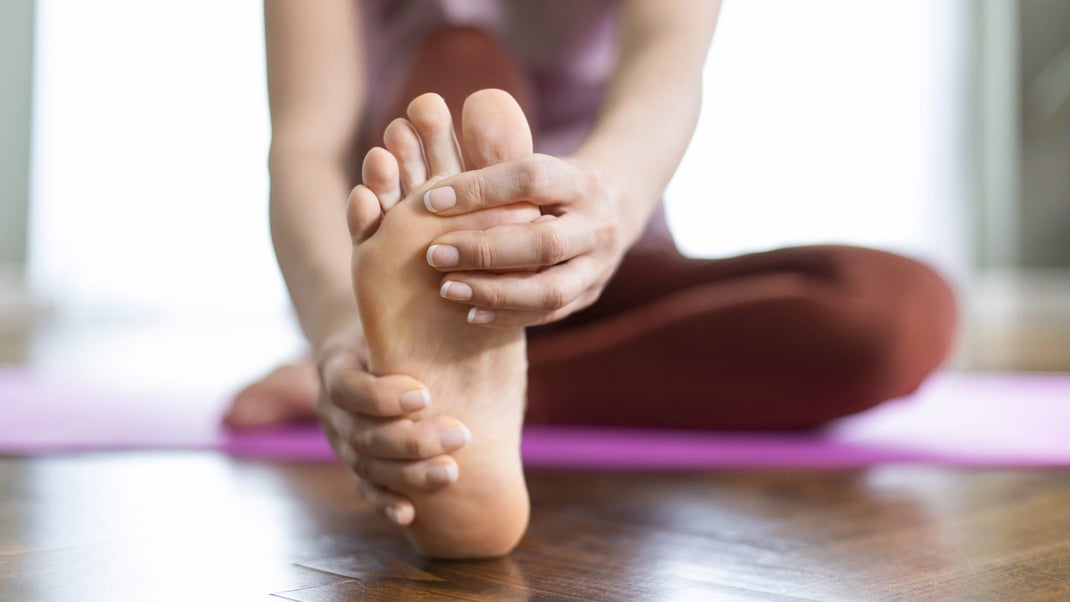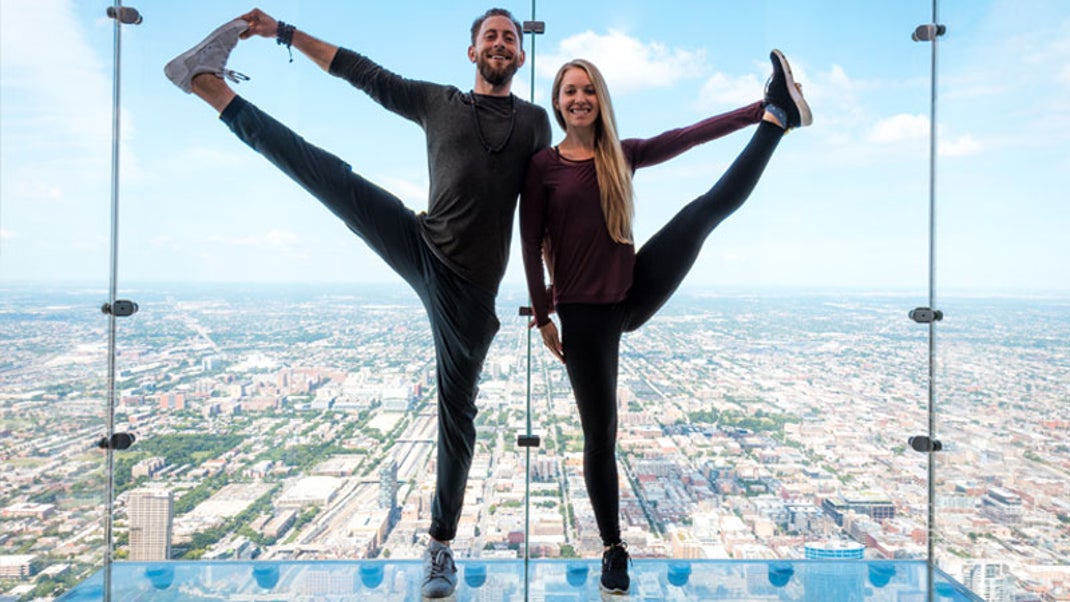In this blog post, we will go over 6 Yoga Stretches for Plantar Fasciitis. This is a condition that affects many people and can be debilitating if left untreated. The good news is that it’s never too late to start treating your pain! You don’t have to live with heel pain any longer – these 6 exercises are just what you need.
You wake up in the morning, sit up and stretch, ready to start your day. But when you swing out of bed and hit the floor, your feet say, “No way!” They’re stiff and painful, and you can’t walk without hobbling. What gives? You could be suffering from plantar fasciitis, an inflammation of the plantar fascia. While this condition is painful, yoga offers some nice plantar fasciitis stretches to help you recover.
What is plantar fasciitis?
Your feet have thick bands of tissue that run along the sole, connecting your heel bone to the toes. These bands, the plantar fascia, are a part of the intricate anatomy of the foot that assists the ligaments and the muscles in maintaining the arches at the sole of the foot.
Yoga teacher and anatomy expert Baxter Bell explain: “This connective tissue is strong, but doesn’t stretch much before running the risk of tearing or becoming inflamed. And, unlike muscles, it doesn’t contract and create active movement in the foot.”
When the plantar fascia is stressed, you can feel pain starting at the heel. If the feeling subsides after you take a few steps, you’re experiencing plantar fasciopathy. Plantar fasciitis—which you may have heard people call “heel spurs”—involves pain that doesn’t ease after you take a few steps to warm them up.
“An –itis implies inflammation, and in this case, the plantar fascia is inflamed,” says Bell.
What causes plantar fasciitis?
Your risk for plantar fasciitis may be based on genetics, posture, activity, or foot care. You are more likely to get plantar fasciitis if you have problems with your arches—if you never developed an arch, have fallen arches, or have unusually high arches. A tendency toward a tight Achilles tendon can also contribute to the condition.
The way you walk or stand may also impact the structure of your feet. If you tend to pronate—roll inward, flattening the arch as you stand or walk—or supinate, rolling the foot outward toward the ankle, you may be putting stress on the plantar fascia. Wearing shoes with poor arch support, shoes that have flat or soft soles, or shoes that are worn down unevenly can affect your stance and the anatomy of your feet.
As you might imagine, anything that stresses the feet can contribute to problems. For example, carrying excess pounds or working a job that keeps you standing or walking on hard surfaces can put you at risk for the condition, according to Andrew McGonigle, author of Supporting Yoga Students with Common Injuries and Conditions.
Your particular form of physical activity can also be a contributing factor. Bell says that when he hears yoga students complaining about pain on the sole of the foot near the heel, he starts asking questions about their activities.
“When I question them further, there is almost always a history of a recent increase in high-impact activity, like starting to train for a running race, or starting new dance classes,” he says. “On rare occasions, they may have just started a yoga boot camp where they are doing a lot of jump backs from Uttanasana to Chaturanga, or from Down Dog to forwarding Fold.”
“Long-distance running, especially running downhill or on uneven surfaces, or any new and continued activity that puts unusual strain on this sheet of tissue, can cause inflammation,” he adds.
How can plantar fasciitis be treated?
Unfortunately, there’s no quick fix for plantar fasciitis. In fact, it can take from two months to two years for this condition to fully resolve. During that time, pay careful attention to how you’re using your feet. A typical orthopedic treatment plan could include resting the feet and limiting activities that might aggravate the condition, wearing a splint at night that keeps the feet immobilized, and using orthotics in your shoes for support. Physical therapy may be recommended—including icing the feet and doing stretches for the Achilles tendon. Your doctor may suggest anti-inflammatory medication, steroid shots, or even surgery in more resistant cases.
Can yoga help plantar fasciitis?
Asana practices can support the therapies mentioned above. Resting poses, such as Legs-up-the-Wall Pose (Viparita Karani) and other inversions that involve having your feet in the air take pressure off the plantar fascia. And poses that stretch the Achilles tendon and the feet can also help (think High Lunge). Many standing poses could also be beneficial if you are careful about your grounding stance. Malasana (Garland Pose), can pull double duty by stretching both the heel and the sole of the foot.
But these poses must be done with mindfulness, so as to avoid further aggravating your symptoms. Certain yoga poses or movements can make the condition worse. (Jump backs are a common culprit.) In those cases, Bell suggests some creative propping to continue to practice without worsening your symptoms: Doubling up your sticky mat for more cushioning can also help. Additionally, you can try using a wedge under the ball of the front foot or the heel of the back foot to minimize stretch on the plantar fascia.
“One of my students whose plantar fasciitis was improving noticed some lingering pain when the affected foot was back in Warrior I Pose. We modified it by using a wedge under that heel,” he says. Another example of a pose that puts a lot of pressure onto the front foot heel is Parsvottanasana (Intense Side Stretch or Pyramid Pose). A wedge under the ball of the front foot in this posture could help.
Practiced with care, yoga can help you keep your feet strong and supple so that you can prevent plantar fasciitis or ease it when it happens. As always, if you want yoga to be part of your healing plan for your feet, work with an experienced teacher who is well versed in the anatomy of the feet and legs.
Plantar fasciitis stretches in your yoga practice
Yoga poses that allow you to gently flex your feet and heels—like Adho Mukha Svanasana (Downward-Facing Dog)—can help ease pain in the feet. Just listen to your body and don’t over-stretch. And remember that when you’re doing yoga therapeutically, consult the advice of an expert.
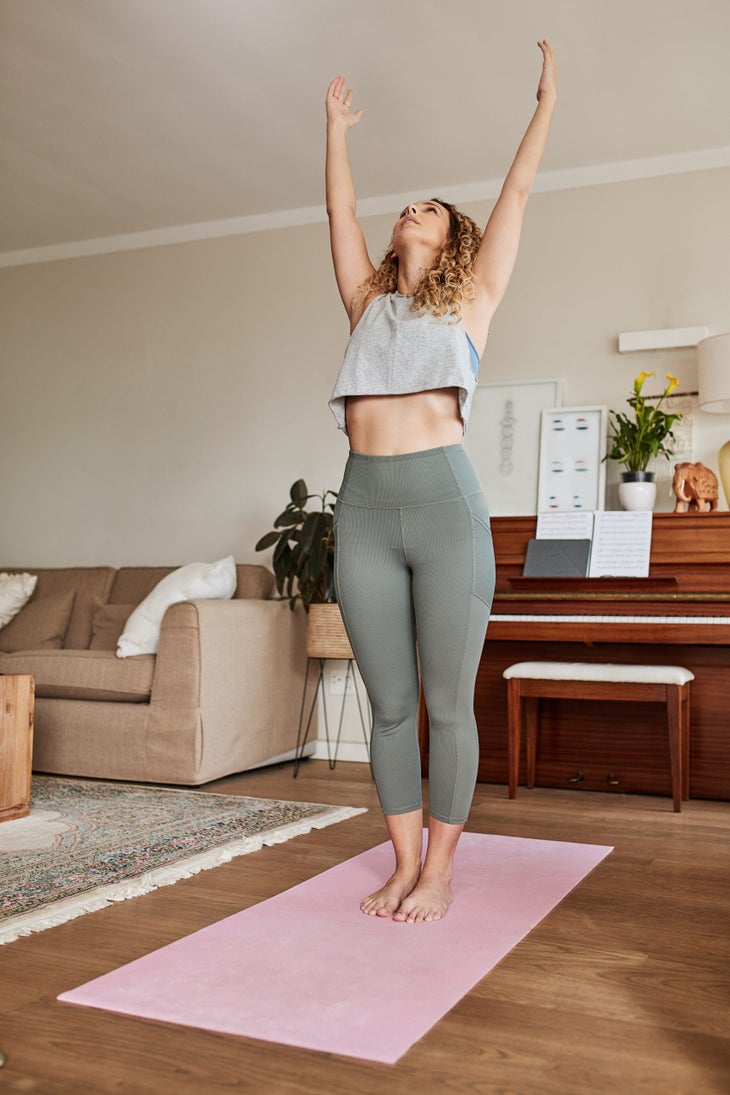
Urdhva Hastasana (Upward Salute)
Tadasana (Mountain Pose) and its upward-reaching cousin are foundational poses that can bring awareness to the structure of your feet and ankles—and how you stand. Stand with feet hip-distance apart and focus on keeping the weight evenly distributed between the heel and the toes. Make sure you’re not pronating or supinating the foot—putting extra weight on the arch or the outside edge of the foot. Practice grounding through the heel and balls of feet and lifting your toes off the floor.
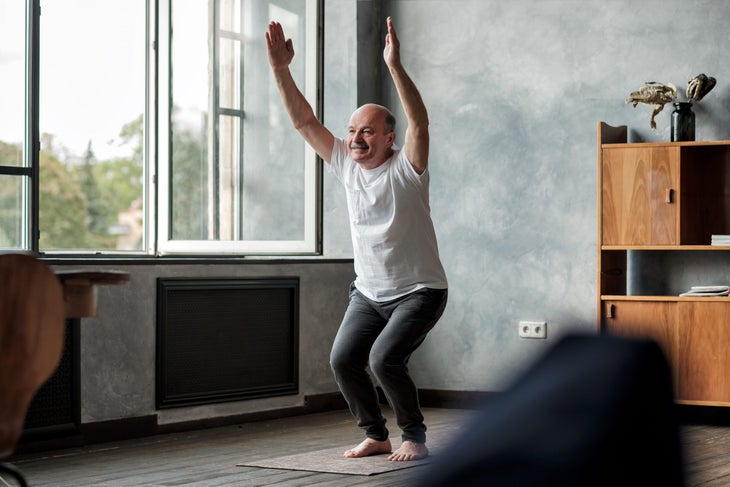
Utkatasana (Chair pose)
For detailed pose instructions see: Yoga Journal Chair PoseFrom Tadasana, bend the knees as if you are sitting down in a chair. Keep your thighs parallel to each other; knees will be over or ahead of the toes. Your torso will lean forward as your hips move back. You can raise your arms straight up overhead, aligned with the torso or, to keep your attention on your legs, but the hands on the hips. This pose flexes the foot and stretches the calf and Achilles tendon.
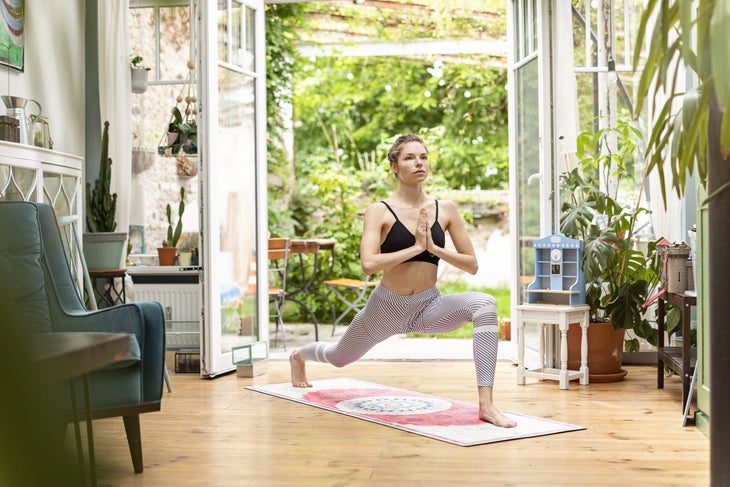
High Lunge
From Tadasana, step your right foot back, keeping the toes facing the front of the mat. Bend your left knee and lower the body, allowing the shin and thigh to make a right angle. Lift your left heel off the floor. Your left leg can be straight or slightly bent to allow you to adjust the amount of stretch in the Achilles and the sole of the foot.
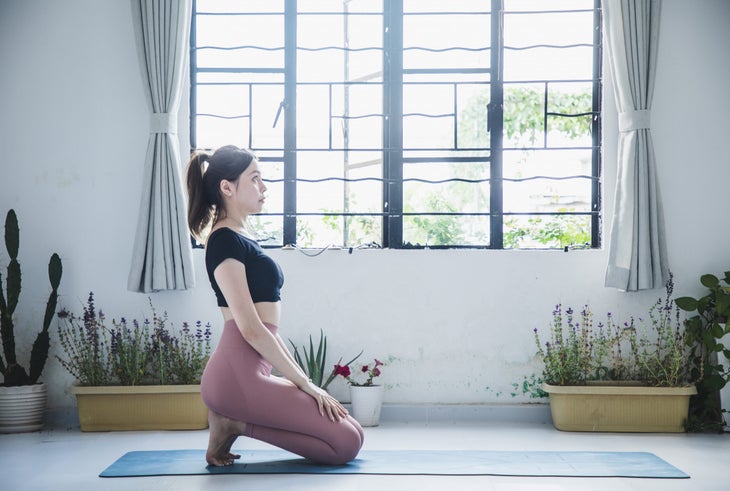
Vajrasana (Thunderbolt Pose) with toes flexed
From Tabletop, sit back on the heels with the knees together, shins parallel, and feet pointing straight. Make sure the toes don’t turn in. “Turning the feet in could be a cause of ankle or knee pain,” according to yoga instructor Di Hickman. This version of Thunderbolt stretches the tops of the feet, ankle, and shins. To stretch the plantar fascia on the bottom of the foot, tuck the toes under, keeping the feet parallel. If either variation seems too intense, place blocks under the sitting bones to keep some weight off your feet.
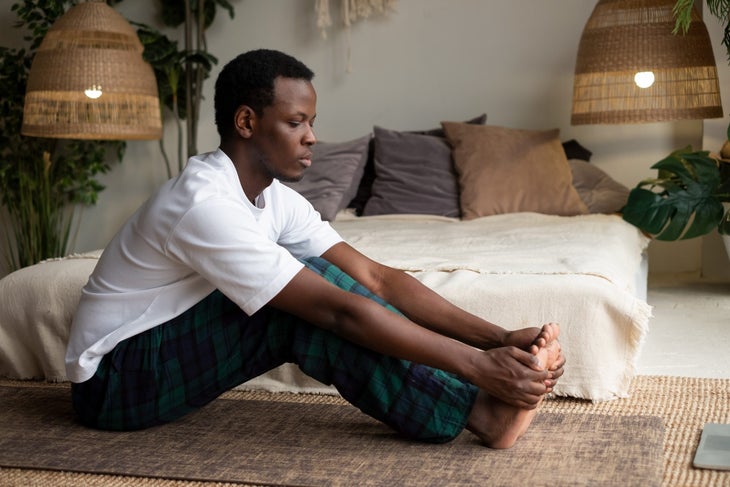
Paschimottanasana (Seated Forward Bend)
From Dandasana, reach the arms up high, hinge at the hips, and reach toward your feet. Keep the feet flexed with the toes pulled back toward your body. If you can reach your toes or the outside of the feet, use your hands to gently encourage your feet to flex and stretch toward your body. Or place a strap at the ball of your feet to help extend your reach. You may also try this pose with the feet against the wall, pressing away with the heels and flexing the toes back.
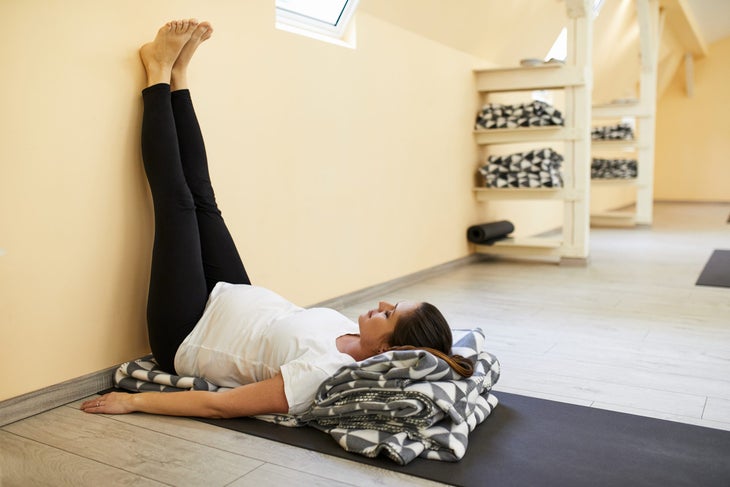
Viparita Karani (Legs-up-the-Wall Pose, variation)
Sit with your right hip snug against the wall. Lean-to the left, supporting yourself with your left arm until you are lying on your side. With a smooth movement, swing your legs up onto the wall, rolling over to lie on your back. You can use a blanket, block, or bolster under the hips. Also, try putting a block or heavy book on the feet to keep them flat and add some weight.
Want to learn more? Cleveland Clinic’s yoga program manager Judi Bar offers these variations to help ease plantar fasciitis:
Tips for avoiding plantar fasciitis
Choose supportive shoes. Avoid shoes that have no arch support, like ballet flats, flip-flops, and even some sneakers. Ditto sky-high heels that aren’t supportive and can also cause instability in your foot and ankle. That doesn’t mean you have to resort to grandma’s orthopedic shoes. Look for interesting, stylish options with innersoles that cup the heel and support the arch. (You can even find flip-flops that support the foot.) Repair or retire shoes when the heels wear down unevenly. You won’t be able to hold your foot in alignment if your heels are rolled in or out.
Support your feet when sitting. Notice your foot position when you sit. Even if you’re not putting weight on the feet, you may hold them in positions that put a strain on the plantar fascia. To give your feet support, sit with your feet flat on the floor or with books, blocks, or a bolster under them.
Give your feet a massage. Rub and manually move your feet when you wake up, when you’ve been sitting for a while, or if you’ve been standing or walking. Teachers often recommend that you take a few moments to give some attention to your feet while you’re sitting in Baddha Konasana (Bound Angle or Cobbler’s Pose).
Conclusion:
Nix Stabbing Heel Pain With 6 Yoga Stretches for Plantar Fasciitis. Try these 6 yoga stretches to help strengthen your arches and ease chronic pain in the soles of your feet or heels, including Vajrasana with toes flexed, Paschimottanasana (Seated Forward Bend), Viparita Karani (Legs-up-the-Wall Pose). Also try giving yourself a massage when you wake up, sit down for long periods of time, or stand on your feet.
